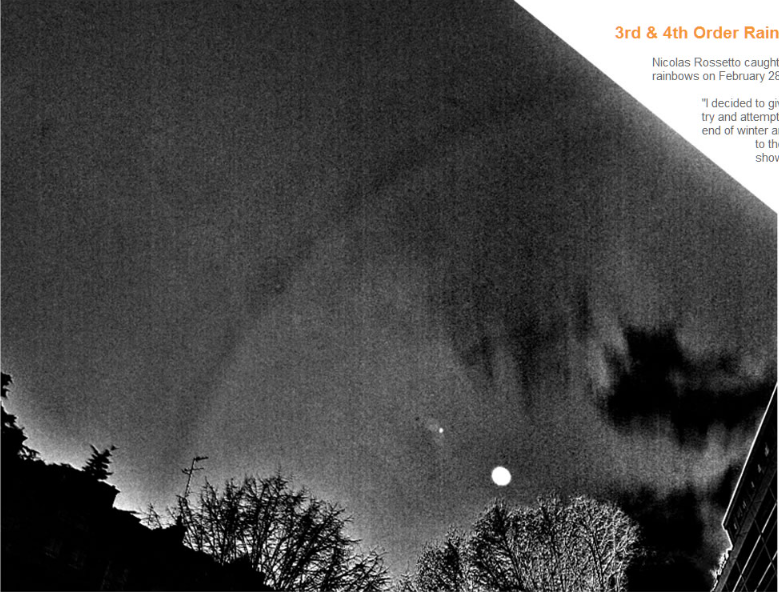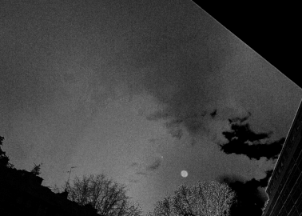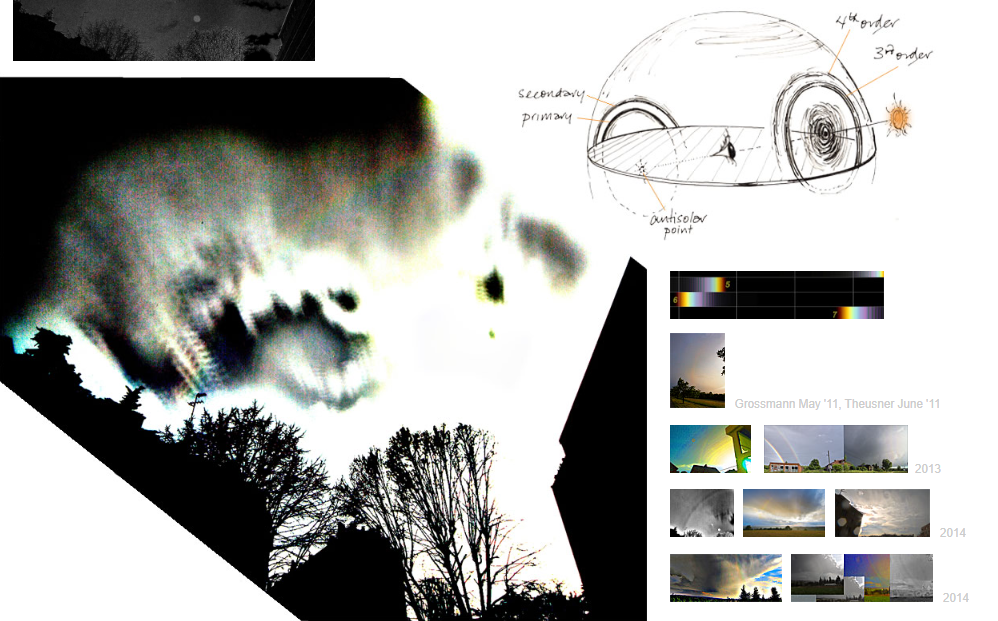Paris 3rd and 4th order rainbows - OPOD
Paris 3rd and 4th Order Rainbows: A Rare Atmospheric Phenomenon
Have you ever heard of 3rd and 4th order rainbows? These elusive and captivating optical phenomena occur when sunlight interacts with raindrops in a very specific way. While they are not commonly observed, Nicolas Rossetto managed to capture these higher order rainbows in Paris on February 28, 2014. Despite the challenging location surrounded by tall buildings, the unique weather conditions at the end of winter and early spring provided the perfect opportunity to witness these remarkable spectacles.
A Challenging Capture
Rossetto's determination led him to embark on the quest to photograph 3rd and 4th order rainbows. He took advantage of the short but intense rain showers followed by sunny breaks, which were ideal for the formation of these rare optical phenomena. As the sun rose higher in February, it provided the necessary angle to illuminate the raindrops and reveal the higher order rainbows. Finally, on that fateful day of February 28th, intense rain showered the capital city of Paris, and the sun emerged just in time to cast its rays from the side, creating the perfect conditions for Rossetto's photographic endeavor.
The Stacking Process
To capture these elusive rainbows, Rossetto employed a technique called stacking. He stacked a series of 17 black and white rendered images with unsharp masking. Each individual rendered image showcased the 3rd order rainbow quite well. However, to enhance the visibility of the 4th order rainbow, a stacking process was necessary. By combining multiple images, Rossetto was able to reveal the intricate details of these higher order rainbows that would have otherwise gone unnoticed.
Understanding 3rd and 4th Order Rainbows
To truly appreciate the rarity and complexity of 3rd and 4th order rainbows, it's important to understand their formation. These rainbows require an improbable occurrence of three and four reflections of sunlight inside the raindrops. During each internal reflection, some light is lost and refracted outside of the drop, contributing to a rainbow of lower order. As a result, the total light intensity of the 3rd order bow is only 24% of the primary rainbow, while the 4th order bow is even weaker at 15%.
Moreover, these higher order rainbows gradually widen as their order increases. The 3rd order rainbow spans approximately 4.4 degrees, while the 4th order rainbow spreads out to about 5.6 degrees. This wider dispersion of light further diminishes the contrast between the bow and the sky, making these rainbows even more challenging to observe and photograph.
A Recent Discovery
The rarity and low intensity of 3rd and 4th order rainbows explain why they were not documented until 2011. However, as our understanding of atmospheric optics has advanced and more people actively search for these phenomena, sightings and images of higher order rainbows are becoming increasingly common. In fact, the 5th order rainbow has already been successfully captured and documented, leaving room for further exploration and discovery of even higher order rainbows in the future.
Conclusion
The Paris 3rd and 4th order rainbows captured by Nicolas Rossetto on February 28, 2014, provide a fascinating glimpse into the world of rare atmospheric optics. Despite the challenging location and limited opportunities to witness these phenomena, Rossetto's determination and favorable weather conditions allowed him to document these elusive rainbows. Through the stacking process, he revealed the intricate details of these higher order rainbows that would have otherwise remained hidden. As our knowledge of atmospheric optics continues to expand, we can expect further exploration and documentation of these captivating optical spectacles in the years to come.

3rd & 4th Order Rainbows, Paris
Nicolas Rossetto caught these very difficult higher order rainbows on February 28, '14.
"I decided to give them <3rd and 4th order rainbows> a try and attempt to catch them as the weather at the end of winter and early spring was particularly adapted to the exercise, with short and intense rain showers and sunny pauses between.
Despite my poor location in Paris (many tall buildings surrounding my spot), at that time of the year the sun rises high enough in February to catch the bows. And the best opportunity I had so far was on 28th when intense rain was showering the capital and the sun popped out just in time to light it from the side."
All images ©Nicolas Rossetto
A stack of 17 black and white rendered images with unsharp Masking.
"Each single rendered image showed the 3rd order quite well, but a stacking process is needed to gain access to the 4th order more clearly."

Third and fourth order rainbows need an improbable three and four reflections of sun rays inside the raindrops. At each internal reflection some light is lost, refracted outside of the drop to go towards a rainbow of lower order. The total light of the 3rd order bow is only 24% of the primary and that of the 4th order 15%. The higher order bows also get progressively wider (3rd
order 4.4°, 4th 5.6°) spreading their light and weakening further the contrast between bow and sky.
Combine their low intensity with their position around the sun and it is no surprise that they were not photographed until 2011. Now they are imaged increasingly often. The 5th order bow has already been nailed to the trophy wall and surely even higher orders will be added.

Note: this article has been automatically converted from the old site and may not appear as intended. You can find the original article here.
Reference Atmospheric Optics
If you use any of the definitions, information, or data presented on Atmospheric Optics, please copy the link or reference below to properly credit us as the reference source. Thank you!
-
<a href="https://atoptics.co.uk/blog/paris-3rd-and-4th-order-rainbows-opod/">Paris 3rd and 4th order rainbows - OPOD</a>
-
"Paris 3rd and 4th order rainbows - OPOD". Atmospheric Optics. Accessed on November 25, 2024. https://atoptics.co.uk/blog/paris-3rd-and-4th-order-rainbows-opod/.
-
"Paris 3rd and 4th order rainbows - OPOD". Atmospheric Optics, https://atoptics.co.uk/blog/paris-3rd-and-4th-order-rainbows-opod/. Accessed 25 November, 2024
-
Paris 3rd and 4th order rainbows - OPOD. Atmospheric Optics. Retrieved from https://atoptics.co.uk/blog/paris-3rd-and-4th-order-rainbows-opod/.